The Role of Hybrid Care in Encouraging Long-Term Wellness Tracking
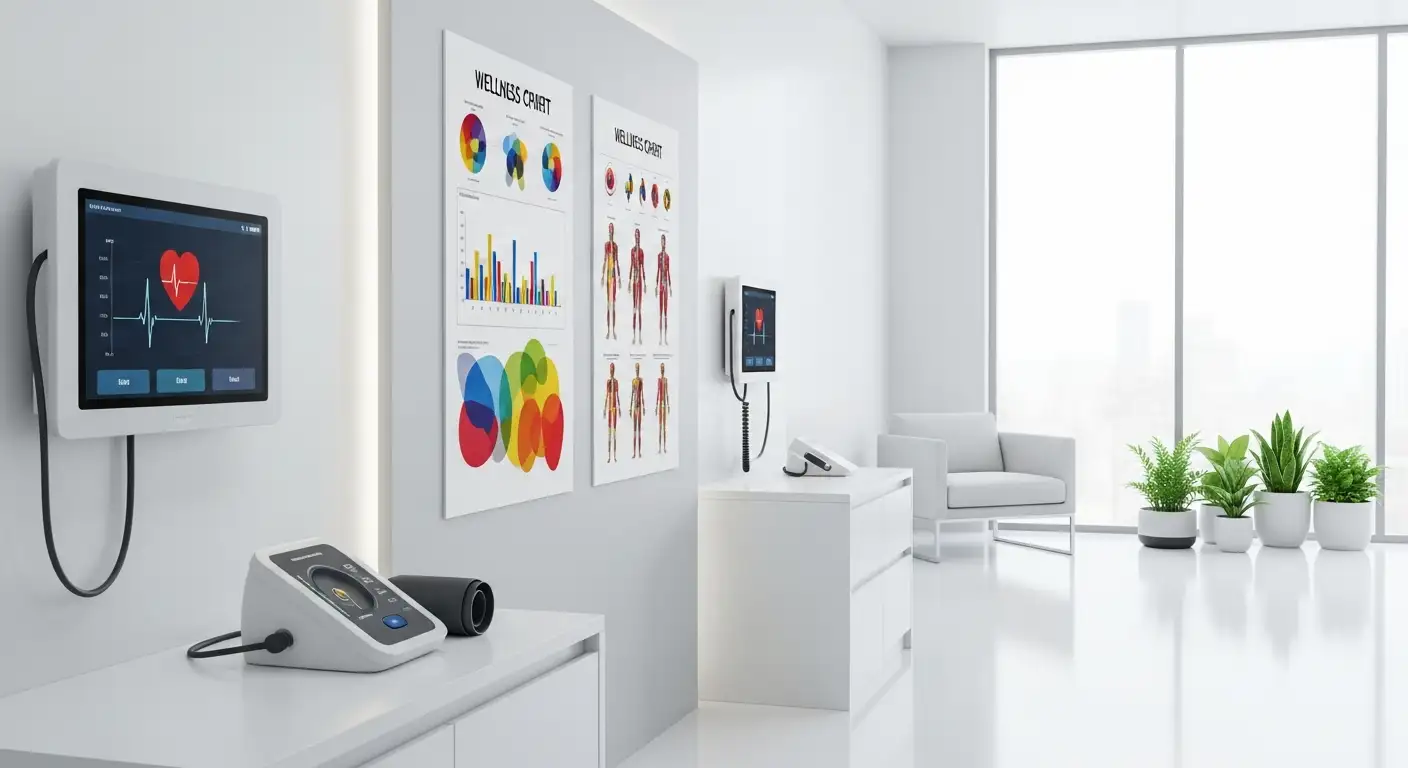
Understanding Hybrid Care Models in Wellness Tracking
As chronic diseases and obesity continue to impose heavy burdens globally, innovative care models have emerged to support long-term wellness tracking and management. Hybrid care programs—integrating digital tools with traditional face-to-face consultations—are shaping the future of chronic disease care and weight loss interventions. This article explores how these hybrid approaches foster sustained behavioral change, enhance clinical outcomes, and empower patients to track and improve their health over time.
Key Components of Effective Wellness Programs in Hybrid Care

What are the core components of wellness programs?
Effective wellness programs offer a broad spectrum of services to support overall health. These include physical activity initiatives, nutritional counseling, mental health support, stress management techniques, and preventive health screenings. Programs may feature fitness classes and vaccination clinics to engage participants actively. Digital health tools also play a crucial role by enabling remote monitoring and education, while financial wellness initiatives support broader aspects of well-being.
How do hybrid programs integrate digital and in-person strategies?
Hybrid wellness models combine telehealth platforms and in-person visits to deliver flexible and comprehensive care. Digital methods include real-time consultations via video call platforms like Zoom or WhatsApp, alongside asynchronous education through tools like Moodle. In-person sessions focus on physical exams and complex assessments tailored to specialties such as nutrition or medicine. This dual approach ensures continuous monitoring and personalized interventions.
What patient engagement methods enhance participation?
Successful programs engage patients through regular, tailored communication, such as weekly health messages and nurse coaching. Providing devices like glucometers, blood pressure monitors, and cellular-enabled scales empowers patients for self-monitoring. Behavior change support, including lifestyle coaching referrals and food logging, increases accountability. Frequent patient interactions correlate strongly with better outcomes, including substantial weight loss and improved metabolic markers.
These integrated components foster adherence, improve clinical endpoints, and reduce healthcare utilization by enabling proactive management of chronic conditions in primary care and remote settings.
Hybrid Care Models: Combining Telehealth and In-Person Consultations
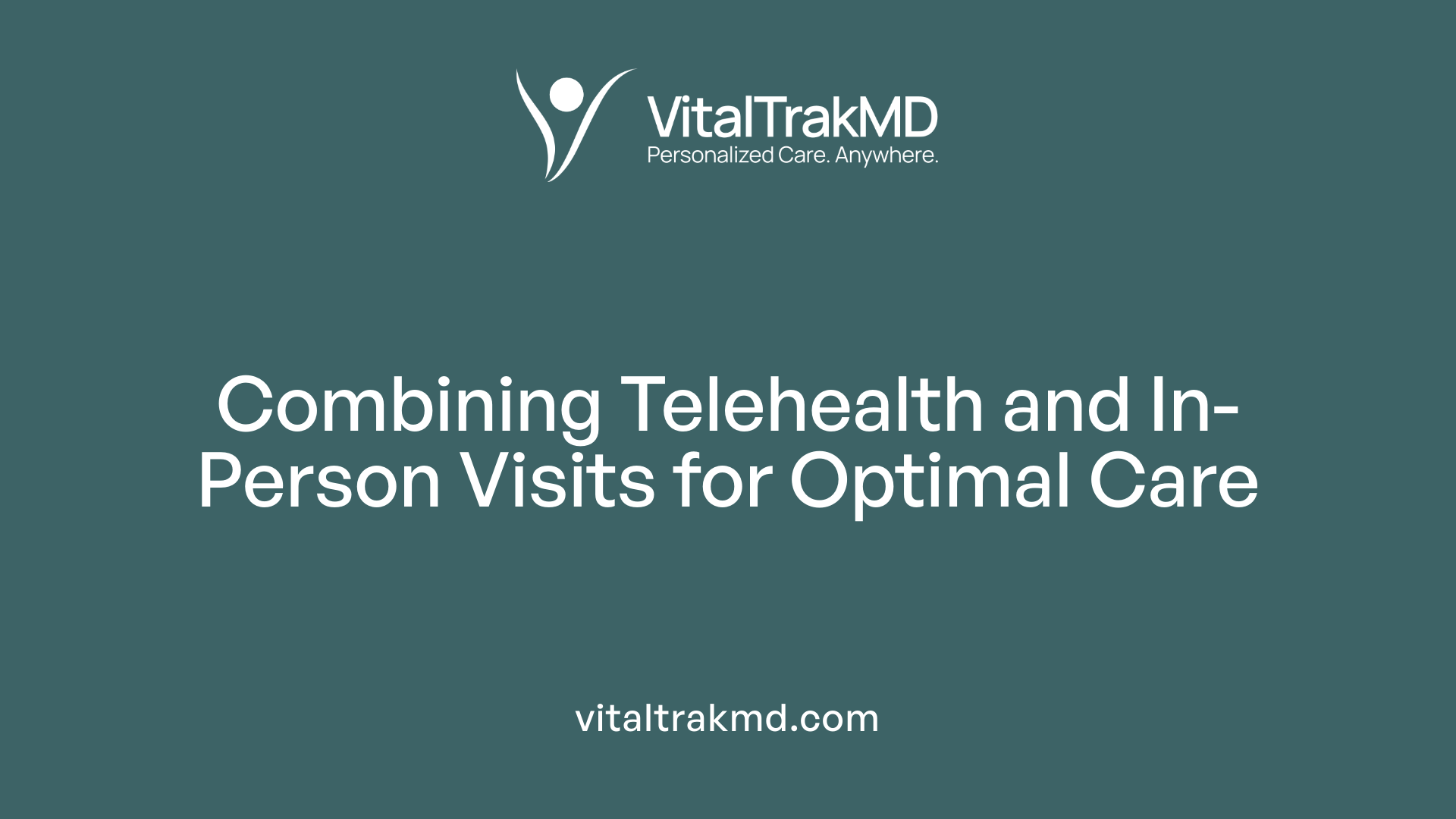
What Is the Structure of Hybrid Care Models?
Hybrid care models (HCM) for chronic disease management integrate telehealth, in-person consultations, and health education into a flexible, comprehensive approach. These models aim to optimize patient outcomes by providing continuous monitoring and tailored interventions. Common chronic conditions addressed include overweight, obesity, prediabetes, diabetes types 1 and 2, and hypertension, with care frequency adjusted by specialty — for example, four visits per year for medicine and three for nutrition.
How Do Telehealth Modalities and Protocols Operate?
Telehealth consultations are conducted via real-time phone and video calls using standardized protocols. Trained providers leverage popular digital platforms such as WhatsApp, Google Meet, Zoom, and Moodle to facilitate remote communication effectively. These interactions enable routine check-ins, patient education, and behavior coaching to promote disease self-management.
What Is the Role of In-Person Examination and Intervention?
In-person visits complement telehealth by focusing on physical examinations, complex diagnostics, and procedural needs that cannot be addressed remotely. These visits are scheduled based on patient complexity and can include clinical assessments and interventions tailored to individual needs, balancing convenience with thorough clinical care.
Which Technology Platforms Are Employed?
The HCM relies on multiple digital technologies: communication platforms (WhatsApp, Google Meet, Zoom, Moodle) enable synchronous and asynchronous interactions for education and coaching. Additionally, patients are supplied with home monitoring devices like glucometers, blood pressure monitors, oximeters, and scales, coupled with training to support self-monitoring. Integration with electronic health records (EHR) allows coordinated care and data-driven decision-making.
This hybrid care framework promotes greater patient engagement, enhances adherence to treatment plans, and reduces the need for unscheduled hospital visits, contributing to both improved health outcomes and healthcare system sustainability.
Digital Education and Teach-Back Methods for Sustained Nutritional Self-Care

What is the Teach-Back Method in Education?
The Teach-Back method is an interactive health education technique where patients are asked to repeat back the information they've learned in their own words. This approach ensures they fully understand essential details about managing their condition, particularly dietary habits.
How Does Digital Nutrition Education Enhance Learning?
Digital education platforms provide flexible and accessible formats for delivering nutrition information. Tools such as synchronous and asynchronous classes via Google Meet and Moodle allow patients to access self-care education conveniently. Combining digital resources with remote communication platforms like WhatsApp and Zoom further supports ongoing engagement.
What Impact Does the Hybrid Program Have on Dietary Habits?
Studies have shown that hybrid self-care education programs pairing the Teach-Back method with digital nutrition education significantly improve dietary quality among chronic disease patients. Notably, unhealthy diet prevalence dropped from 98.67% to 49.34%, while adherence to healthy diets rose from 0% to 13.33%. These changes are sustained over 12 months, indicating lasting benefits.
How Does This Approach Affect Nutritional Self-Care?
By confirming patient understanding and providing continuous digital support, the hybrid model empowers individuals to better manage their nutrition. This leads to improved cardiometabolic control, reduced cardiovascular risk factors, and enhanced therapeutic adherence, demonstrating the effectiveness of this educational strategy in long-term health outcomes.
Long-Term Clinical Improvements Through Hybrid Self-Care Programs

How do hybrid self-care programs impact cardiovascular risk reduction over 12 months?
Hybrid self-care education programs that combine Teach-Back methods with digital education have been shown to significantly reduce cardiovascular risk markers. Over a period of 12 months, participants exhibited notable decreases in systolic blood pressure from 142.21 mmHg to 132.22 mmHg and diastolic blood pressure from 104.70 mmHg to 92.16 mmHg. These improvements contribute to lowering the overall risk of cardiovascular events.
What changes in blood pressure and glucose control have been observed?
In addition to blood pressure improvements, fasting blood glucose levels declined markedly, from 212.66 mg/dL at baseline to 151.48 mg/dL after one year. This reflects enhanced glycemic control among patients with chronic conditions. The combination of educational interventions with digital monitoring tools supports consistent management and adherence to treatment plans.
How has BMI been affected over the 12-month follow-up?
Body Mass Index (BMI), a critical indicator for obesity and related health outcomes, decreased significantly in participants. The average BMI fell from 27.91 kg/m² to 25.32 kg/m² within one year. This reduction aligns with improved diet and lifestyle behaviors fostered through the hybrid care model.
Are the effects of the intervention durable over time?
Importantly, the positive effects on dietary habits, metabolic markers, and cardiovascular health indicators were sustained at the 12-month follow-up. This durability underscores the effectiveness of ongoing support and continued patient engagement facilitated by hybrid care approaches. It highlights the value of integrating in-person and digital education to maintain long-term health benefits.
Role of Virtual Obesity Care in Expanding Access to Weight Loss

How Do Virtual Obesity Care Programs Scale Access to Weight Loss Interventions?
Virtual obesity care programs provide a scalable solution for delivering weight loss interventions broadly. By leveraging digital platforms such as telehealth consultations, remote coaching, and mobile-enabled self-monitoring devices, these programs reach a wide population without geographic constraints. Programs have demonstrated feasibility with large cohorts, such as one including 66,094 participants, indicating that virtual care models can serve high volumes of patients effectively.
How Do Virtual Programs Overcome Geographic and Resource Limitations?
Virtual obesity care overcomes traditional access barriers by eliminating the need for frequent in-person visits. Patients can engage through structured phone or video calls and use devices like cellular-enabled weight scales at home. This flexibility allows individuals in remote or underserved areas to participate and maintain continuous engagement. Additionally, virtual platforms facilitate ongoing behavioral support, critical for sustained outcomes, without the burden of travel or time away from work.
What Is the Role of Antiobesity Medications in Virtual Weight Loss Programs?
Antiobesity medications are integral to many virtual obesity care programs, enhancing outcomes beyond lifestyle changes alone. Digital tools combined with pharmacotherapy enable personalized treatment plans and continuous monitoring. Medications prescribed range from older, affordable drugs to newer, highly effective GLP-1 receptor agonists. The combination has translated into meaningful weight loss, with over half of patients achieving clinically significant reductions within six to twelve months.
Which Medication Types Are Used and How Effective Are They?
Common medications include older agents and newer GLP-1 receptor agonists like semaglutide and liraglutide. Clinical trial data align closely with virtual program outcomes, showing average weight losses up to 8% at 12 months, with higher engagement pushing this to 12%. Nearly two-thirds of users lost at least 5% of body weight, a threshold associated with health benefits. These findings underline the efficacy of combining modern pharmacotherapy with digital engagement in obesity management.
Behavior Change Tools Enhancing Weight Loss Outcomes in Digital Programs
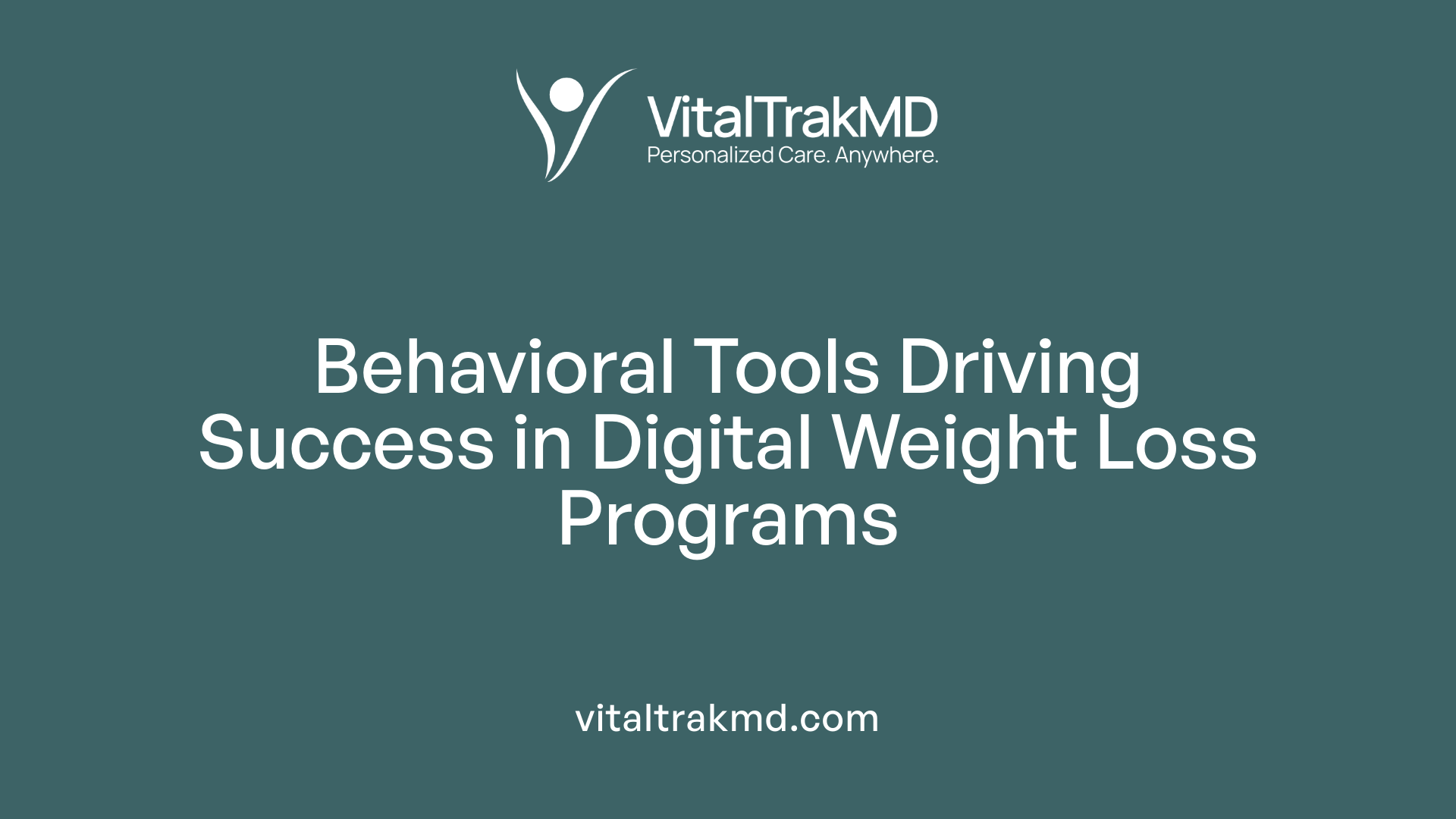
How does self-monitoring and frequent engagement impact weight loss?
Self-monitoring, such as weekly logging of weight, plays a crucial role in enhancing weight loss outcomes in digital programs. Participants who consistently track their progress tend to achieve greater reductions in weight. For example, patients logging their weight weekly in a virtual obesity care program have been shown to lose up to 12% of their body weight, compared to the average 8% weight loss across all participants.
What behavioral supports and coaching improve outcomes in digital weight management?
Behavioral supports, including tailored messages and nurse coaching, significantly increase patient engagement and weight loss success. Weekly personalized outreach messages and remote coaching have been proven to promote consistent self-weighing and encourage enrollment in lifestyle coaching resources. For instance, nurse coaching increased self-weighing rates by over 20 percentage points and enrollment in coaching programs by 15 percentage points compared to phases without active support.
What weight loss percentages are typically achieved in these digital programs?
Digital programs that integrate behavior change tools alongside medication and lifestyle management show encouraging weight loss results. Nearly two-thirds of users achieve at least 5% weight loss at 12 months, a clinically meaningful threshold associated with health benefits. Median weight reductions reach 8% at 12 months in large populations, with some patients losing more than 10 to 15% of their initial body weight when actively engaged.
These findings highlight the critical role of behavioral tools such as self-monitoring, coaching, and tailored communication in supporting sustained weight loss in digital care settings.
Integration of Pharmacotherapy and Lifestyle Guidance in Hybrid Models

How Are GLP-1 Receptor Agonists and Older Antiobesity Medications Used in Hybrid Care Models?
Hybrid care models for weight loss integrate both pharmacotherapy and lifestyle guidance to optimize outcomes. These models utilize a combination of antiobesity medications, including older, low-cost options and newer, more effective GLP-1 receptor agonists such as semaglutide and liraglutide. Their use has been linked to meaningful weight loss consistent with clinical trial data, with over half of patients achieving at least 5% weight loss by six months and nearly two-thirds by one year.
Why Is Guidance and Monitoring Important in Pharmacotherapy for Obesity?
Guidance and continuous monitoring are critical in pharmacotherapy to ensure safe and effective weight management. Ongoing supervision helps in preventing unfavorable outcomes and assists in adjusting treatments as needed. Digital tools facilitate real-time data collection, including food logs and glucose levels, enabling personalized care that supports sustainable behavioral changes. Regular engagement with self-monitoring equipment and remote consultations fosters greater therapeutic adherence.
How Do Multidisciplinary Teams and Continuous Patient Engagement Enhance Hybrid Models?
Successful hybrid care involves a multidisciplinary approach combining medical providers, nutritionists, and behavioral coaches working together. This team approach allows comprehensive management of weight and metabolic conditions. Continuous patient engagement through both in-person visits and telehealth platforms ensures consistent support. Digital technologies facilitate communication and offer tailored support such as weekly messages and coaching, increasing patient motivation and adherence to lifestyle and medication regimens.
| Component | Description | Impact on Patient Care |
|---|---|---|
| Pharmacotherapy | Use of GLP-1 receptor agonists and older medications | Enhanced weight loss outcomes |
| Guidance and Monitoring | Continuous support with digital tools and clinical follow-up | Improved safety and adherence |
| Multidisciplinary Care Team | Integration of medicine, nutrition, and behavioral coaching | Comprehensive chronic disease management |
| Continuous Engagement | Telehealth, remote coaching, and digital self-monitoring devices | Sustained behavioral changes and better clinical outcomes |
Patient Monitoring Technologies for Self-Management in Hybrid Care

Devices Provided for Self-Monitoring
In hybrid care models targeting chronic conditions like obesity, hypertension, and diabetes, patients are equipped with various devices to facilitate self-monitoring. Commonly provided tools include glucometers for blood sugar tracking, blood pressure monitors to manage hypertension, pulse oximeters, and digital scales for weight measurement. These devices empower patients to track critical health parameters from home, enabling timely responses to changes in their condition.
Training Patients on Device Use
Proper usage of monitoring equipment is crucial for obtaining accurate data. Health education programs include comprehensive training sessions where patients learn how to correctly operate each device. This training ensures reliable measurements and builds patient confidence in managing their health independently. By fostering competence, the hybrid care model supports sustained engagement and adherence to self-care routines.
Continuous Data Collection for Personalized Care
Beyond basic self-monitoring, continuous data collection using digital tools like food logs, glucose monitors, and other digital biomarkers enhances personalized care. These data streams feed into electronic health records and remote coaching platforms, allowing clinicians to tailor interventions based on real-time information. This integration enables proactive adjustments to treatment plans and supports behavioral changes necessary for long-term management of chronic diseases.
Health Education Delivery: Synchronous and Asynchronous Approaches
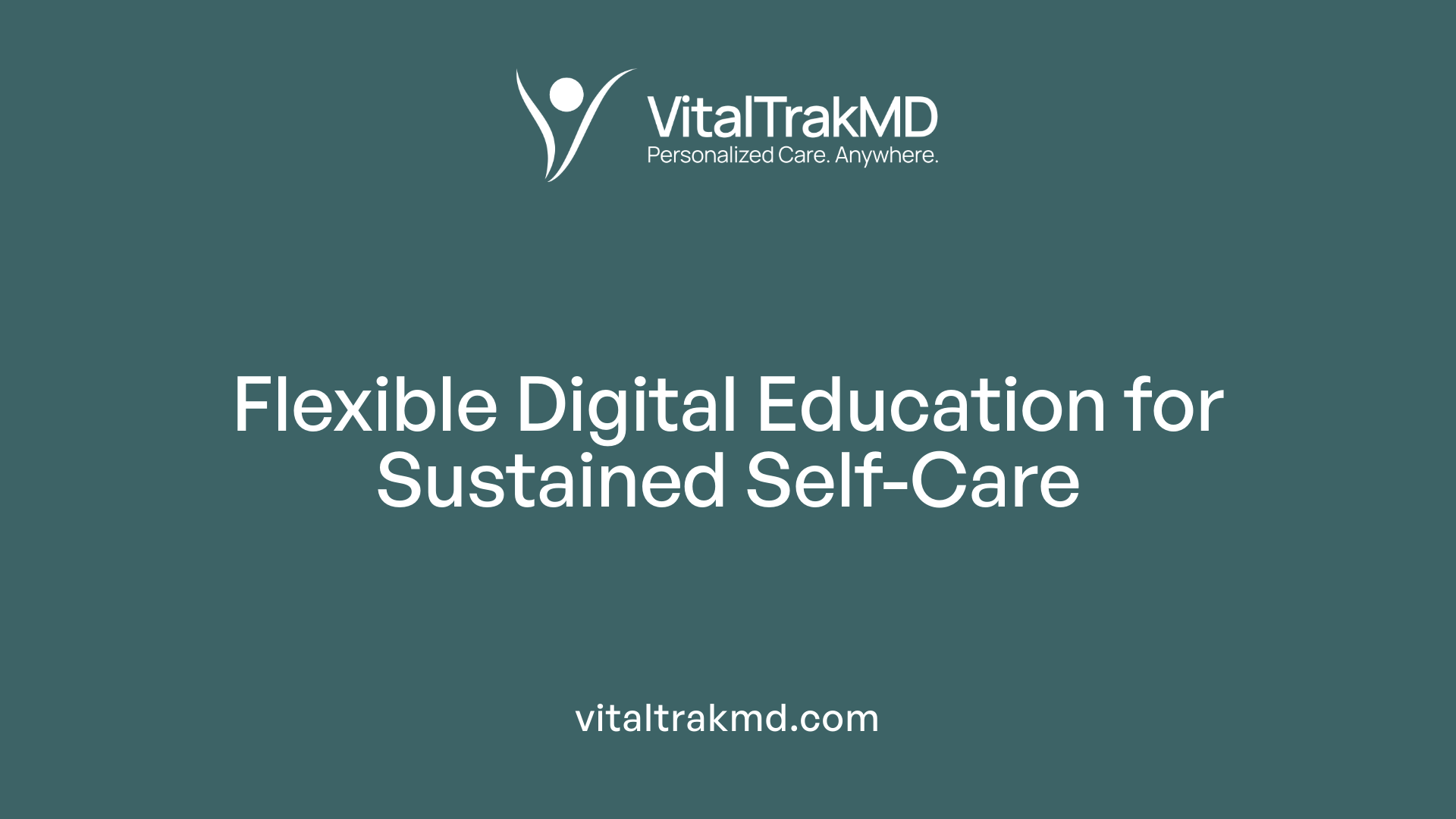
Digital platforms for education (Google Meet, Moodle)
The hybrid care model employs widely accessible digital platforms such as Google Meet and Moodle to deliver health education. These tools facilitate both synchronous (live) and asynchronous (self-paced) learning, accommodating diverse patient schedules and learning preferences. Live sessions on Google Meet enable real-time interaction with educators, allowing patients to ask questions and receive immediate feedback. Moodle supports asynchronous content access, providing flexibility for patients to revisit educational materials at their own pace.
Class content on disease management and self-care
Educational content focuses on self-care practices and disease management related to conditions like overweight, obesity, metabolic syndrome, and diabetes. Classes cover topics such as dietary habits, physical activity, medication adherence, and monitoring of health parameters. The curriculum is designed to empower patients with knowledge and skills that promote sustained behavioral changes, improving cardiometabolic outcomes as evidenced by significant reductions in blood pressure, glucose levels, and BMI in participants.
Patient acceptance and challenges
Patient feedback has generally been positive, highlighting the understandability and acceptability of the hybrid education components. However, some patients report challenges related to trust and emotional barriers that may hinder full engagement with weight management programs. These nuances underscore the importance of personalized support and continuous follow-up to address psychological factors and reinforce motivation. Digital tools coupled with trained healthcare staff help mitigate these barriers by providing tailored coaching and fostering ongoing patient-provider communication.
Evidence Supporting Hybrid Care Models During Health Crises

How effective are hybrid care models during the COVID-19 pandemic?
Hybrid care models have proven highly effective in managing chronic diseases through the COVID-19 pandemic. By combining telehealth consultations, in-person visits, and health education, these models offer continuous monitoring and flexible patient support. A study involving 1,412 patients with conditions such as obesity, diabetes, and hypertension demonstrated improved cardiometabolic control and reduced unscheduled healthcare visits. The integrative approach ensures patients maintain regular contact with healthcare providers despite social distancing measures, supporting sustained health improvements during crises.
How do hybrid models reduce unscheduled and emergency visits?
The incorporation of structured telehealth and in-person care permits early identification and management of complications, reducing the need for emergency room visits and hospitalizations. Remote monitoring with devices like glucometers and blood pressure cuffs enables patients to track vital signs effectively, with healthcare teams responding promptly to concerning trends. This proactive management approach fosters therapeutic adherence and timely interventions, significantly decreasing unscheduled visits as shown in urban community clinic settings during the pandemic.
What are the sustainability and healthcare cost impacts of hybrid care models?
Hybrid care models promote sustainability by minimizing patient travel, reducing the carbon footprint associated with healthcare delivery. They also alleviate pressure on clinical resources by optimizing in-person appointment necessity through telehealth. Cost analyses estimate the initial 6-month expense per patient at approximately US $335, suggesting economic feasibility for healthcare systems. Additionally, enhanced disease control decreases long-term costs linked to complications, positioning hybrid models as both environmentally and financially sustainable solutions for chronic disease management in challenging times.
Recruitment, Engagement, and Cost Feasibility in Hybrid Weight Loss Programs
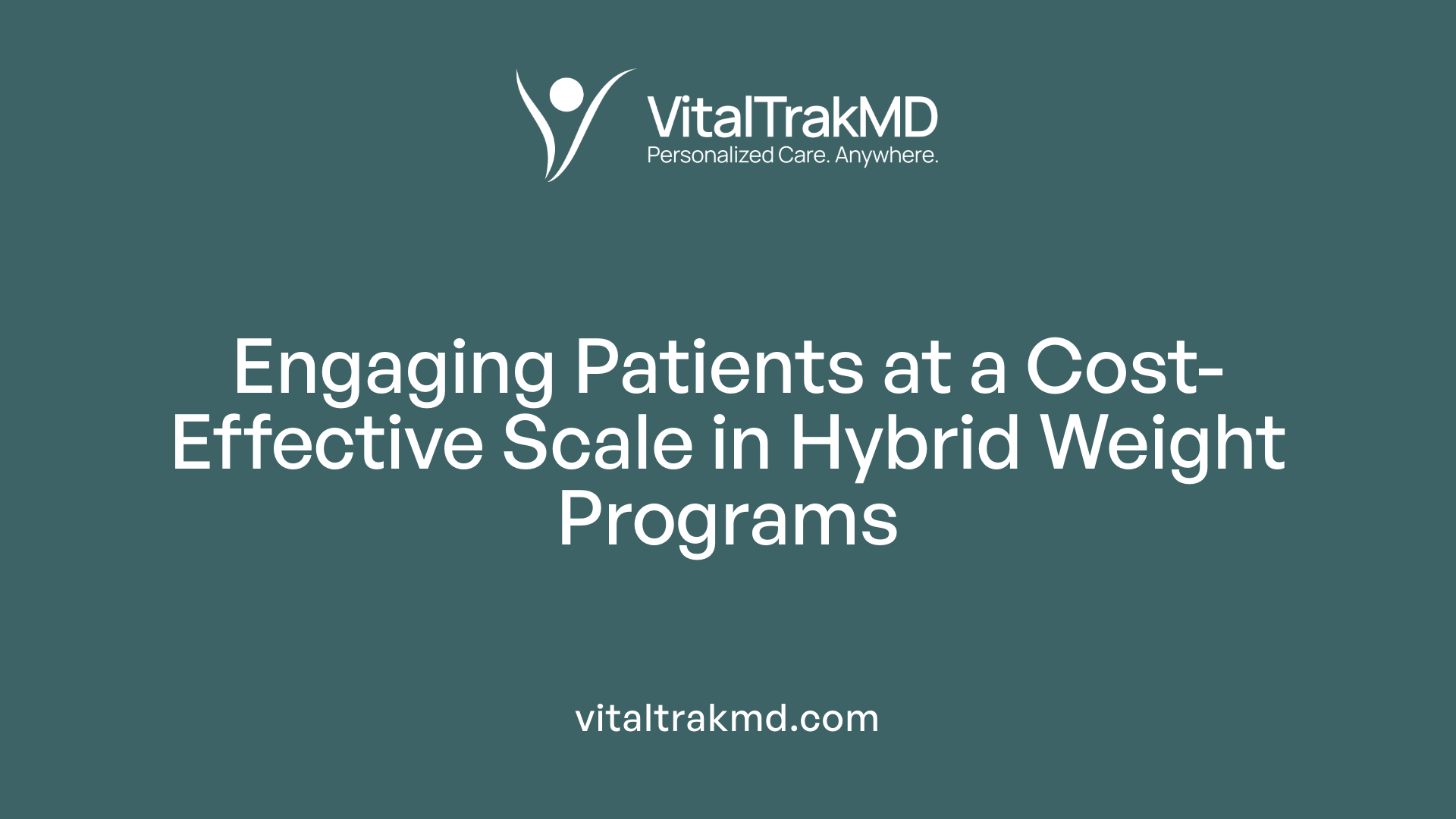
How are participants recruited and what is the uptake in hybrid weight loss programs?
Recruitment efforts employed outreach messages targeting 426 patients over a six-week period, resulting in 80 enrollments. This indicates a feasible recruitment process within primary care settings for hybrid interventions blending technology and personal coaching.
What engagement metrics demonstrate participant involvement?
Engagement was significantly enhanced through customized support, including weekly tailored messages and nurse coaching. Self-weighing frequency increased from 21% to 43%, while enrollment in coaching resources rose from 37% to 52% during active support phases. These metrics underscore the effectiveness of personalized communication in sustaining patient involvement.
What are the cost estimates and system feasibility for these programs?
The total healthcare system cost per participant for the initial six months was approximately US $335, suggesting the program is cost-feasible. Leveraging existing clinical workflows and technology platforms, the model is designed for integration into busy primary care practices, thus promoting sustainability and scalability.
Patient Experience and Emotional Barriers in Hybrid Wellness Programs
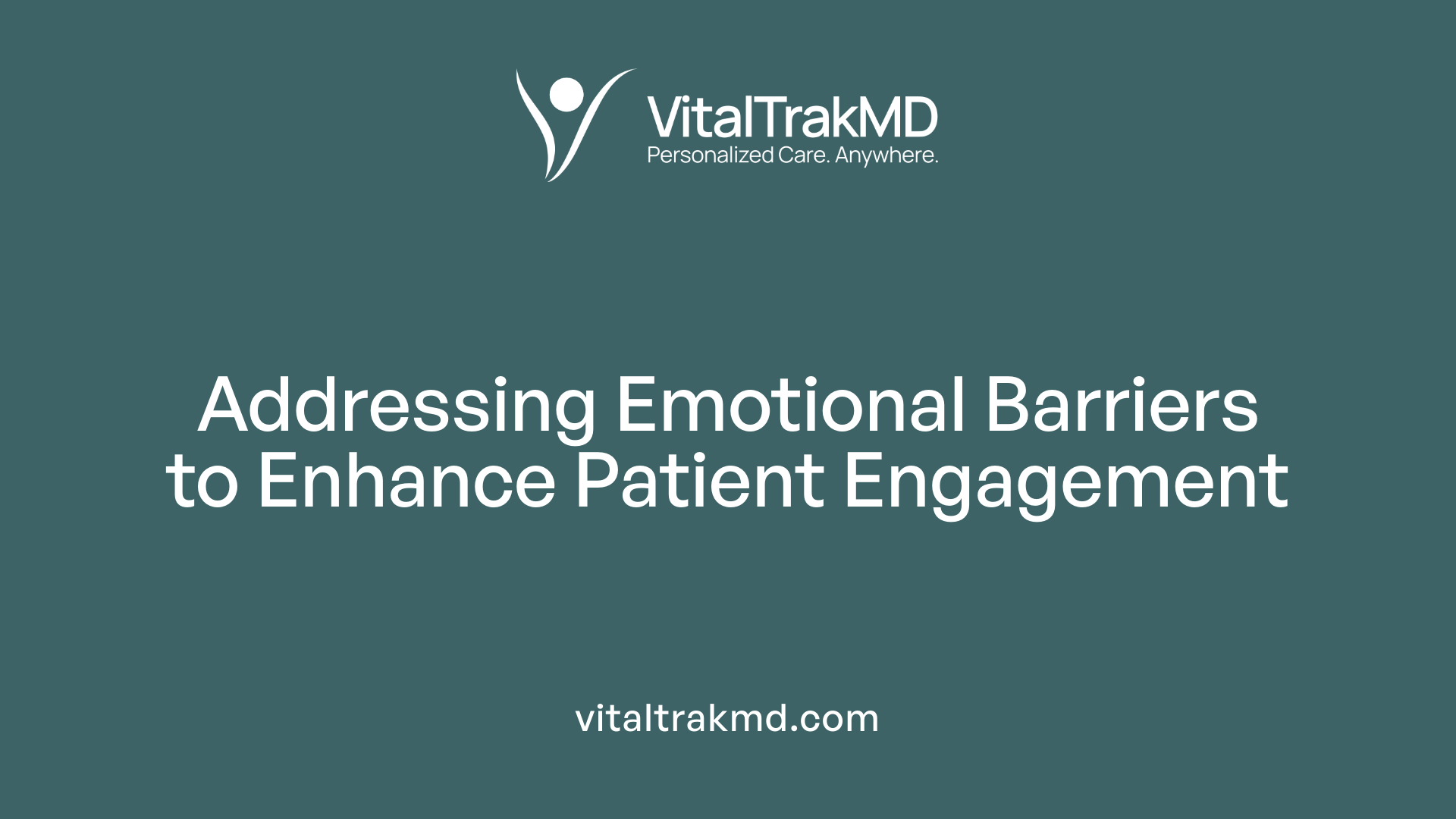
What feedback have patients provided about the components of hybrid wellness programs?
Patients generally found the components of hybrid wellness programs understandable and acceptable. These programs, which often combine technology-driven tools like digital education, weight scales, and remote coaching with in-person consultations, offer a variety of support options tailored to individual needs. Many participants appreciated the accessibility and flexibility afforded by virtual tools and personalized messaging, which made self-care and weight management more manageable within their daily lives.
Are there trust issues and emotional challenges experienced by patients?
Despite the overall positive reception, some patients expressed trust issues and emotional barriers related to their participation. Concerns about the reliability of digital tools, privacy of health information, and skepticism over program effectiveness were noted. Emotional challenges included feelings of frustration and discouragement with weight management struggles, exacerbated by the self-monitoring expectations and perceived judgment. These factors sometimes hindered sustained engagement and adherence to program components.
What strategies can enhance trust and boost engagement?
To address these challenges, hybrid wellness programs incorporate several strategies. Customized support involving weekly tailored messages and nurse coaching has shown increased engagement levels, fostering a more personal connection despite remote interactions. Emphasizing transparency about data use and program goals helps build patient trust. Additionally, iterative program design that actively incorporates patient feedback ensures interventions remain relevant and responsive to users’ emotional and psychological needs. Education on proper equipment use and digital literacy further empowers participants, reducing anxiety about technology.
By attentively managing emotional barriers and trust issues through thoughtful program design and personalized communication, hybrid wellness programs can strengthen patient participation and promote long-term health behavior change.
The Impact of Continuous Data Collection on Personalized Behavioral Change

How do food logs, glucose monitoring, and digital biomarkers contribute to personalized care?
Continuous data collection tools such as food logs, glucose monitors, and digital biomarkers provide rich, real-time insights into a patient's health status and behaviors. Food logs help track dietary intake, enabling identification of nutritional patterns and potential triggers for unhealthy eating. Glucose monitoring offers immediate feedback on blood sugar fluctuations, critical for managing conditions like prediabetes and diabetes. Digital biomarkers, collected via wearable devices and apps, encompass broader physiological data such as heart rate, activity levels, and sleep patterns, painting a comprehensive picture of a patient's health.
What role do these data play in tailoring interventions?
By collecting continuous and detailed patient information, healthcare providers can customize treatment plans more effectively. For example, patterns from food logs identify when dietary adjustments are needed, while glucose data highlight responses to medication or lifestyle changes. Digital biomarkers can signal early signs of deterioration or improvements, allowing timely intervention. This tailored approach ensures patients receive the right support at the right time, improving the precision and relevance of behavioral guidance.
How does continuous data collection enhance patient adherence and monitoring?
The availability of continuous feedback motivates patients to adhere to prescribed lifestyle changes and medication regimens. It encourages self-awareness, empowering patients to make informed decisions day-to-day. Moreover, healthcare teams can remotely monitor progress, quickly identifying issues and providing timely coaching or adjustments. This dynamic interaction fosters sustained engagement and better long-term outcomes in managing chronic conditions.
| Continuous Data Tools | Purpose | Impact on Care |
|---|---|---|
| Food Logs | Track dietary intake | Identify dietary patterns, tailor nutritional advice |
| Glucose Monitoring | Monitor blood sugar levels | Inform medication and lifestyle adjustments |
| Digital Biomarkers | Collect physiological data from devices | Provide comprehensive health insights, detect trends |
This integration of continuous data collection within hybrid care models drives effective, personalized behavioral changes essential for managing chronic diseases.
Sustaining Long-Term Weight Loss: Importance of Ongoing Support and Monitoring

How do weight loss programs support long-term success?
Weight loss programs foster long-term success primarily through sustainable lifestyle changes. These include adopting balanced nutrition, engaging in regular physical activity, and managing stress effectively. Programs emphasize behavioral strategies such as self-monitoring—patients log their weight and food intake regularly—which has been shown to correlate with greater weight loss, sometimes up to 12% of body weight.
Ongoing behavioral support systems play a crucial role. Counseling, nurse coaching, and community support groups provide motivation, enhance adherence, and prevent relapse. For example, hybrid care models offering weekly tailored messages and coaching increase patient engagement in healthy behaviors like self-weighing and lifestyle coaching enrollment.
Behavioral support systems and community resources
Sustained weight reduction benefits from continued behavioral support through both digital and in-person channels. Hybrid self-care education programs combine telehealth consultations and health education, delivered synchronously via platforms like Google Meet and asynchronously via Moodle. These tools enable continuous interaction and feedback.
Community resources and structured support, such as partnerships with fitness organizations, provide accessible lifestyle coaching that complements clinical care. Patient feedback generally shows high acceptability and understanding of these supports, though addressing emotional barriers is essential to maximize effectiveness.
Long-term pharmacotherapy adherence
Pharmacotherapy, especially with antiobesity medications like GLP-1 receptor agonists (e.g., semaglutide, liraglutide), is an important adjunct in maintaining weight loss. Studies demonstrate that combining these medications with behavioral tools enhances outcomes—over 64% of patients achieve clinically significant weight loss (≥5%) at 12 months.
Critical to success is long-term adherence and ongoing monitoring during pharmacotherapy to optimize benefits and avoid adverse effects. Hybrid care models support this with remote coaching, telehealth follow-ups, and integration into primary care workflows.
Environmental and policy support for healthy lifestyles
Supporting environments and policies are vital for maintaining weight loss. Reduction of healthcare costs and environmental impact is achieved by minimizing travel thanks to telehealth components. Moreover, community-level encouragement for physical activity and access to healthy foods reinforce individual behavior changes promoted by care models.
Such multifaceted support—from individual behavioral changes to medication adherence and supportive environments—forms the backbone for sustaining weight loss in patients with chronic conditions over the long term.
The Essential Role of Care Programs in Chronic Condition Management

What role do care programs play in managing chronic conditions?
Care programs are vital in managing chronic conditions by offering coordinated, patient-centered care tailored to individual needs. These programs ensure that care providers communicate effectively through organized care coordination, fostering personalized care plans that adapt to each patient's unique health situation.
Care coordination and patient-centered planning
By integrating telehealth consultations, in-person visits, and educational sessions, hybrid care models deliver flexible chronic disease management. This approach allows for continuous monitoring and personalized adjustments, improving therapeutic adherence and reducing hospital visits.
Medication management and patient education
Effective care programs incorporate medication management with patient education to support lifestyle changes. Use of antiobesity medications such as GLP-1 receptor agonists combined with behavioral strategies leads to meaningful and sustained weight loss. Patients benefit from ongoing guidance and monitoring to maximize medication effectiveness and avoid adverse outcomes.
Use of EHRs, telehealth, and analytics
Utilizing electronic health records (EHRs), telehealth platforms, and data analytics allows seamless patient monitoring and remote coaching. Digital tools enable self-monitoring through devices like glucometers and scales, facilitating real-time feedback and personalized interventions. This technology-supported approach enhances patient engagement and optimizes clinical outcomes.
Improved outcomes and reduced costs
These comprehensive care models demonstrate significant improvements in dietary habits, blood pressure, glucose control, BMI, and cardiovascular risk markers over long-term follow-up. Additionally, they reduce healthcare costs by decreasing emergency and hospital visits while promoting environmental sustainability by minimizing patient travel. Overall, care programs are integral to enhancing health outcomes, patient satisfaction, and cost-effective management of chronic diseases.
Looking Ahead: The Future of Hybrid Care in Wellness Tracking
Hybrid care models represent a transformative approach to long-term wellness tracking and chronic disease management. By blending digital education, telehealth, in-person consultations, and continuous patient engagement, these programs effectively support sustainable lifestyle changes, improve clinical outcomes, and expand access to care. The integration of pharmacotherapy, self-monitoring technologies, and personalized behavioral interventions further enhances their impact. As healthcare continues to evolve, hybrid care offers a promising framework to address the growing demands of chronic disease and obesity management. Investing in patient-centered hybrid care programs not only reduces healthcare costs but also empowers patients to take lasting control of their health, ultimately fostering healthier communities globally.
References
- Sustainable effects of a hybrid self-care education program ...
- Long‐Term Weight Loss Outcomes in a Virtual Weight Care ...
- Development of an evidence-based hybrid model in the ...
- Hybrid Health IT and Telehealth–Delivered Behavioral Weight ...
- Effectiveness of a hybrid approach in integrating GLP-1 ...
- Designing and Managing Effective Wellness Programs
- Promoting Health and Wellness in the Workplace
- Weight-Loss and Maintenance Strategies - NCBI - NIH
Recent articles
Want to Feel Better and Live Healthier?
Join hundreds of patients taking control of their health with personalized care that fits their life – not the other way around.
Rated 4.8/5 by 32+ customers







